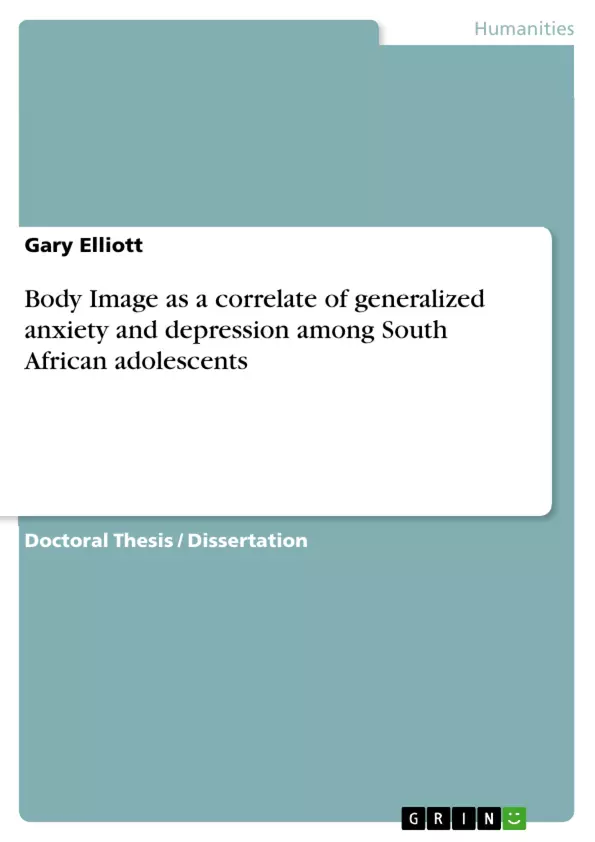The main objective of this study was to conduct an empirical investigation to gather information from adolescents in the Pretoria area as to their level of body image dissatisfaction, anxiety and depression. This information was used to identify whether correlations exist between these three variables for South African youth.
A literature study was conducted and the following hypotheses were developed for study:
I. Adolescent females report higher (more severe) levels of body image dissatisfaction than males.
II. Depression rates among South African adolescents have a female-to-male ratio of 2:1.
III. Depression prevalence rates among South African adolescents are lower than their American counterparts.
IV. Adolescent females display higher levels of anxiety than their male counterparts.
V. A significant positive correlation exists between levels of body image dissatisfaction and levels of depression.
VI. A significant positive correlation exists between levels of body image dissatisfaction and feelings of anxiety.
VII. There is a significant positive correlation between levels of depression and anxiety in South African adolescents.
The gathering of quantitative data took the form of a structured questionnaire comprising four distinct sections: demographic information, the Body Image Satisfaction scale, the Choate Depression Inventory for Children (CDIC), and the Hospital Anxiety and Depression (HAD) scale. The questionnaire was administered to Grade 8-12 learners (aged 13-19 years old) to three different high school in the area, both independent and public schools. The sample group was randomly selected and yielded 350 completed questionnaires.
Inhaltsverzeichnis (Table of Contents)
- Introduction
- Literature Review
- Body Image
- Anxiety
- Depression
- Methodology
- Participants
- Instruments
- Procedure
- Data Analysis
- Results
- Discussion
- Recommendations
- References
Zielsetzung und Themenschwerpunkte (Objectives and Key Themes)
The study aimed to examine the relationship between body image dissatisfaction, anxiety, and depression among South African adolescents in the Pretoria area. The study sought to identify correlations between these three variables and to investigate potential gender differences in their prevalence.
- Body Image Dissatisfaction in South African Adolescents
- Anxiety and Depression Prevalence in South African Adolescents
- Gender Differences in Body Image, Anxiety, and Depression
- Correlations Between Body Image Dissatisfaction, Anxiety, and Depression
- Comparison of South African Adolescent Data to American Prevalence Rates
Zusammenfassung der Kapitel (Chapter Summaries)
The study begins with a comprehensive review of existing literature on body image, anxiety, and depression, particularly within the context of adolescence. This review lays the foundation for the study's objectives and hypotheses. The methodology chapter details the participant selection, the instruments used, the data collection process, and the statistical analysis methods employed. The results chapter presents the findings of the study, including descriptive statistics, correlations, and gender-based comparisons. The discussion section interprets the findings in relation to existing literature, explores potential explanations for the observed results, and highlights the study's limitations. Finally, the recommendations section suggests future research directions and practical implications for addressing body image concerns, anxiety, and depression among South African adolescents.
Schlüsselwörter (Keywords)
Body Image, Anxiety, Depression, South African Adolescents, Gender Differences, Correlations, Prevalence Rates, Body Image Satisfaction Scale, Choate Depression Inventory for Children (CDIC), Hospital Anxiety and Depression (HAD) scale.
- Quote paper
- Gary Elliott (Author), 2011, Body Image as a correlate of generalized anxiety and depression among South African adolescents, Munich, GRIN Verlag, https://www.grin.com/document/178247



